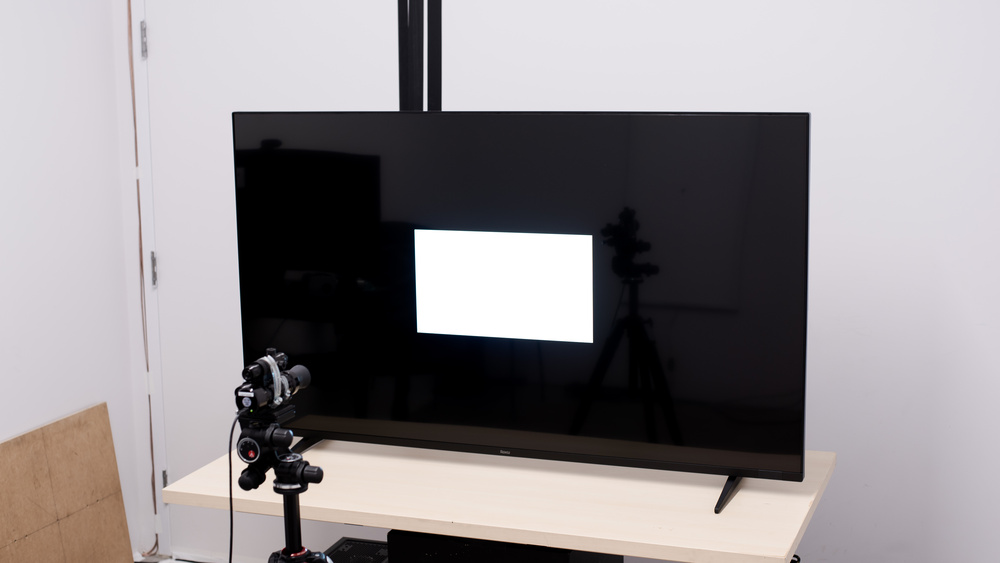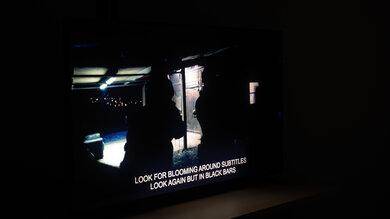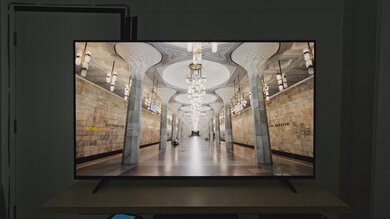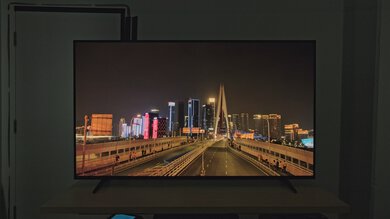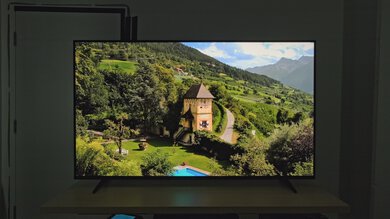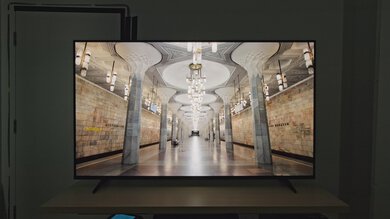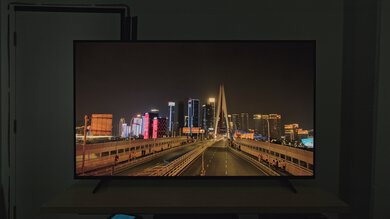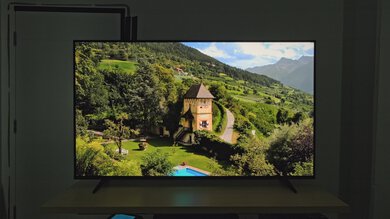The Roku Pro Series QLED is the top model in Roku's 2024 lineup of TVs and is sold alongside the lower-end 2023 Roku Plus Series QLED and Roku Select Series. Unlike these models, the Pro has a Mini-LED panel, letting it portray more vibrant images. The Pro also has more advanced gaming features, like two full HDMI 2.1 bandwidth ports, up to 4k @ 120Hz, full VRR support, and Auto-Low-Latency-Mode (ALLM). Like the Roku Plus Series, the Pro has local dimming and supports both Dolby Vision and HDR10+. It comes with version 13 of Roku's fast and intuitive Roku TV smart OS, and its remote comes with an integrated microphone for voice commands. The TV is available in three sizes: 55, 65, and 75 inches.
Our Verdict
The Roku Pro Series QLED is good overall. It has fantastic contrast and excellent HDR brightness, so it looks amazing when watching HDR content in dark rooms. It also gets very bright in SDR and has decent reflection handling, so it handles bright rooms very well, although its semi-gloss coating is better suited to ambient sources of light, as it struggles a bit more when bright light sources are placed directly opposite it. Unfortunately, the TV's viewing angle is inadequate, so it's a poor choice for a wide seating arrangement, like when watching sports or shows with friends. The TV is at its best when watching high-quality 4k content from physical sources, as its image processing capabilities are disappointing when dealing with low-quality or low-bitrate content. Thankfully, it's a very good gaming TV with fantastic input lag, great response time, and a full set of features like 4k @ 120Hz support, as well as VRR.
-
Amazing contrast delivers deep blacks.
-
Excellent HDR brightness for bright highlights that stand out.
-
Great response time for minimal blur behind fast motion.
-
Bright enough to fight glare in SDR.
-
Image degrades when viewed from the sides.
-
Disappointing image processing.
The Roku Pro Series QLED is alright for TV shows. It has excellent SDR brightness and decent reflection handling, so it's bright enough to handle glare in bright rooms, although it performs better with indirect sources of light than with direct sources of light, like windows placed directly opposite the TV. Unfortunately, its viewing angle is inadequate, so this is a poor choice for watching shows in a wide seating arrangement. Plus, the TV's image processing is disappointing, so lower-resolution shows from DVDs or shows from streaming services don't look as good as they could.
-
Bright enough to fight glare in SDR.
-
Image degrades when viewed from the sides.
-
Disappointing image processing.
The Roku Pro Series QLED is satisfactory for sports. It has decent reflection handling and easily gets bright enough in SDR to handle glare from bright rooms, although it struggles a bit with direct sources of light, like with windows placed directly opposite the screen. It has a great response time, so there's minimal blur when watching fast-moving sports. Unfortunately, the TV has an inadequate viewing angle, so it's a poor choice for a wide viewing arrangement. Its gray uniformity is good, especially with bright uniform colors, making it a great choice for sports like hockey or football, although there's still some visible dirty screen effect, as well as some banding.
-
Great response time for minimal blur behind fast motion.
-
Bright enough to fight glare in SDR.
-
Image degrades when viewed from the sides.
-
Disappointing image processing.
The Roku Pro Series QLED is an excellent choice for gaming. It looks great in Game Mode, with fantastic contrast, excellent SDR peak brightness, and a wide color gamut for a vibrant gaming experience. The TV also has decent reflection handling and handles bright gaming rooms well, although it's better suited for rooms with ambient sources of light rather than those with lights placed directly opposite the TV. Gaming on this TV is extremely responsive due to its fantastic input lag and great response time, although its response time is a bit slower in dark scenes, leading to black smearing. Finally, the TV is fully featured for gamers, with up to 4k @ 120Hz support on its two HDMI 2.1 ports and full VRR support.
-
HDMI 2.1 bandwidth on two ports, up to 4k @ 120 Hz, and VRR support.
-
Great response time for minimal blur behind fast motion.
-
Incredibly low input lag for a responsive experience.
-
Bright enough to fight glare in SDR.
-
Disappointing image processing.
The Roku Pro Series QLED is good for watching movies. The TV's contrast is fantastic, so dark scenes look amazing in a dark room. Its HDR brightness is excellent; highlights really pop on this TV. Unfortunately, the TV's pre-calibration color accuracy is inadequate; you'll have to hire a calibrator if you care about accuracy in SDR. Its accuracy is better in HDR but is still only decent, so it doesn't follow the content creator's intent that closely. Furthermore, the TV's image processing capabilities are limited; movies from streaming platforms have noticeable compression artifacts in dark scenes, and it barely sharpens low-resolution movies from DVDs when upscaling them.
-
Amazing contrast delivers deep blacks.
-
Excellent HDR brightness for bright highlights that stand out.
-
Wide color gamut and great color volume for vibrant, lifelike, and bright colors.
-
Dolby Vision support.
-
Image degrades when viewed from the sides.
-
Inadequate SDR pre-calibration accuracy.
-
Disappointing image processing.
-
Doesn't remove judder from most sources.
The Roku Pro Series QLED is very good for playing HDR-enabled games. Its HDR brightness in Game Mode is excellent, as highlights pop just as much in Game Mode as they do in the other calibrated picture modes. The TV has a truly fantastic contrast ratio, so playing HDR games in a dark room is a treat on this TV. Its input lag is fantastic, so your inputs are quick and responsive, and its response time is great overall, so there's minimal blur in fast-moving games. However, its response time is worse in dark content, so this isn't the best TV for horror games. Finally, the TV is fully featured for gamers, with up to 4k @ 120Hz support on its two HDMI 2.1 ports, Dolby Vision gaming at 60Hz, and full VRR support.
-
Amazing contrast delivers deep blacks.
-
Excellent HDR brightness for bright highlights that stand out.
-
Wide color gamut and great color volume for vibrant, lifelike, and bright colors.
-
HDMI 2.1 bandwidth on two ports, up to 4k @ 120 Hz, and VRR support.
-
Great response time for minimal blur behind fast motion.
-
Incredibly low input lag for a responsive experience.
The Roku Pro Series QLED is a great TV to use as a PC monitor. It has excellent SDR peak brightness and decent reflection handling, so it handles bright offices well; just make sure to avoid placing bright lights directly opposite the TV, as the TV has a harder time with direct reflections versus ambient sources of light. Unfortunately, its viewing angle is inadequate, so the sides of the screen look washed out when you're sitting close to the TV. Still, the TV does proper chroma 4:4:4 with low input lag to give you the sharpest text alongside a very responsive experience, helped by the TV's great response time. Just make sure to avoid setting your apps and operating system to dark mode, as the TV's response time is slower when coming out of dark states.
-
HDMI 2.1 bandwidth on two ports, up to 4k @ 120 Hz, and VRR support.
-
Great response time for minimal blur behind fast motion.
-
Incredibly low input lag for a responsive experience.
-
Bright enough to fight glare in SDR.
-
Displays proper chroma 4:4:4 with the lowest input lag.
-
Image degrades when viewed from the sides.
-
Some noticeable uniformity issues with darker colors.
- 7.6 Mixed Usage
- 6.9 TV Shows
- 7.3 Sports
- 8.7 Video Games
- 7.5 HDR Movies
- 8.7 HDR Gaming
- 8.4 PC Monitor
- Updated Jul 02, 2024: Review published.
- Updated Jun 26, 2024: Early access published.
- Updated Jun 14, 2024: Our testers have started testing this product.
- Updated May 29, 2024: The product has arrived in our lab, and our testers will start evaluating it soon.
- Updated May 03, 2024: We've purchased the product and are waiting for it to arrive in our lab.
Differences Between Sizes And Variants
We tested the 65-inch Roku Pro Series QLED TV (65R8B5), but it's also available in 55 and 75-inch sizes, and most of these results are also valid for those sizes. The number of local dimming zones varies between sizes, so the contrast and dark room performance, in general, are slightly different depending on which size you get. Manufacturers don't typically provide zone counts for different sizes, so we don't know how different they are. Generally, bigger sizes have more zones and, thus, slightly better local dimming performance, and vice versa for the smaller sizes.
| Size | US Model |
|---|---|
| 55" | Roku 55R8B5 |
| 65" | Roku 65R8B5 |
| 75" | Roku 75R8B5 |
You can see the TV's label here.
Compared To Other TVs
The Roku Pro Series QLED is a good TV overall; its contrast is outstanding, it's extremely bright in both SDR and HDR, and it's jam-packed with features for gamers. Unfortunately, it has some flaws, like poor image processing, some bugs, and inadequate pre-calibration accuracy. This makes it better suited for usages where image accuracy and image processing are less important, like for gaming. Still, those shopping for the Roku Pro would be better off going for the Hisense U7N, as the Hisense outperforms the Roku in most metrics while being sold at a significantly lower price.
See our recommendations for the best TVs for gaming, the best smart TVs, and the best 4k TVs.
The LG C4 OLED is much better than the Roku Pro Series QLED. The Roku has fantastic contrast, but the LG is an OLED, so it has even better contrast for a more immersive dark room experience. The Roku is a bit brighter in HDR and much brighter in SDR, but the LG has vastly better reflection handling, so it looks better than the Roku in most lighting configurations. Otherwise, the LG offers better image quality across the board, is more accurate, and is overall the far better option for almost anyone.
The Hisense U7N is better than the Roku Pro Series QLED. The Roku has a slight edge in contrast, but aside from that, the Hisense offers better image quality across the board due to its better image processing and image accuracy. The Roku is a tremendous gaming TV, but the Hisense is even better due to its slightly faster response time, 4k @ 144Hz support, and lower input lag than the Roku at 120Hz and 144Hz (the latter of which the Roku doesn't support).
The TCL Q7/Q750G QLED is better than the Roku Pro Series QLED for anyone who cares about image processing, as the Roku is quite substandard in that regard. But for those who don't care about image processing, the Roku does offer generally better image quality due to its better HDR and SDR peak brightness and wider color gamut. For gamers both TVs are about equally as good, although the TCL has a slight edge for PC gamers due to its 4k @ 144Hz support on two HDMI ports, while the Roku maxes out at 4k @ 120Hz.
The Roku Pro Series QLED is better than the Roku Plus Series QLED. They're very similar TVs when it comes to image processing; they're both inadequate in that regard. However, the Pro Series offers much better image quality than the Plus Series due to its higher HDR and SDR peak brightness, and much better contrast. Still, the Plus Series is the more accurate of the two TVs, so color purists might be bothered by the Pro's accuracy failings. Finally, the Pro Series is also better for gamers due to its 4k @ 120Hz support on its two HDMI 2.1 ports and full VRR capabilities.
Test Results
The TV's feet are basic; they don't feel very sturdy, and the TV wobbles easily when pushed, although it settles quickly. They're wide-set, so you'll need a wide TV table if you're not planning on wall-mounting it. The feet use rotating knobs to tighten up once attached to the TV, so they don't require any tools for assembly.
Footprint of the 65-inch stand: 44.8" x 14.3". The feet raise the screen about 2.4 inches above the table, which is a tight fit for many soundbars, so plan your setup accordingly.
The back of the Roku Pro Series QLED is entirely made of sturdy plastic with a unique, hefty industrial look. It's completely flat, so it will sit flush against the wall if you device to have it wall-mounted. It has the standard VESA mounting points on the back. There's also a slot at the top for Roku's Pro Series TV Wall Mount Kit (sold separately), which is hinged, so it lets you pull the TV away from the wall for easy access to the inputs.
Otherwise, the inputs, which are on the right-hand side while looking at the TV from the front, are hard to access when the TV is flush against the wall as they are recessed into the back panel. The TV has velcro straps on the back to help funnel the cables from the inputs towards the bottom, to help with cable management.
The Roku Pro Series QLED has good build quality. Even though it noticeably wobbles front to back when pushed, the TV itself is made of sturdy plastic and has a unique style choice with metal borders and an industrial look. There's a bit of flex on the back panel around the inputs and towards the middle of the panel, but this is common and won't cause any issues.
The Roku Pro Series QLED has barely acceptable lighting zone transitions. The leading edge of bright moving objects is visibly dimmer, and fast-moving small objects are almost completely obscured due to how dim they get in the transition.
The Roku Pro Series has excellent HDR brightness, so highlights really stand out during darker scenes. Combined with its fantastic contrast, this TV provides an impactful HDR viewing experience.
These measurements are after calibrating the HDR white point with the following settings:
- HDR Picture Mode: Dark HDR
- TV Brightness: Brighter
- Backlight: 100
- Contrast: 50
- Local Dimming: High
- Game Mode: Off
- Dynamic Tone Mapping: Off
- Color Temperature: Warm
Results with Dynamic Tone Mapping set to 'On':
- Hallway Lights: 849 cd/m²
- Yellow Skyscraper: 321 cd/m²
- Landscape Pool: 430 cd/m²
The Roku Pro Series's HDR brightness is about the same in Game Mode, so the TV's highlights look equally as excellent as they do outside of it.
These measurements are after calibrating the HDR white point with the following settings:
- HDR Picture Mode: Dark HDR
- TV Brightness: Brighter
- Backlight: 100
- Contrast: 50
- Local Dimming: High
- Game Mode: On
- Dynamic Tone Mapping: Off
- Color Temperature: Warm
Results with Dynamic Tone Mapping set to 'On':
- Hallway Lights: 847 cd/m²
- Yellow Skyscraper: 313 cd/m²
- Landscape Pool: 421 cd/m²
The TV's PQ EOTF tracking is decent. Still, near-blacks are raised, shadows are too dark, and the rest of the TV's midtones and bright highlights are overbrightened. Unlike on the Roku Plus Series QLED, enabling Dynamic Tone Mapping on this model leads to excessive brightening, as you can see here. The TV has a sharp roll-off near its peak brightness to preserve bright detail in content mastered at 4000 nits. The TV is bright enough to properly display highlights in content mastered at 600 and 1000 nits, so the roll-off isn't necessary with those.
The Roku Pro Series has amazing SDR brightness, easily overcoming glare in very bright rooms.
These measurements are after calibration with the following settings:
- Picture Mode: Movie
- TV Brightness: Brighter
- Backlight: 100
- Contrast: 50
- Local Dimming: High
- Color Temperature: Warm
- Gamma correction: 2.2 (recommended)
The TV has an excellent color gamut, displaying a wide range of colors with HDR content. It has fantastic coverage of the commonly used DCI-P3 color space. The TV has good coverage of the wider, but not as common, Rec. 2020 color space, although here greens, cyans, and yellows are somewhat inaccurate, as well as being undersaturated.
The TV has great color volume. Dark saturated colors are displayed well due to the TV's fantastic contrast, and it displays a wide range of colors at high luminance levels.
The TV has disappointing pre-calibration accuracy. Its white balance is terrible, with significant accuracy errors throughout every range of gray except blacks. The TV's gamma is far too dark in relation to the reference target of 2.2. The TV's color accuracy is decent; undersaturated colors show a lot of accuracy errors, but the errors go down as the colors get more saturated. The TV's color temperature leans too warm, giving everything a reddish tint.
The Roku Pro Series QLED is easy to calibrate. Everything works as expected, without any settings 'sticking' or misbehaving.
You can see the full calibration settings we used here.
The TV has good gray uniformity, especially with brighter scenes of uniform color, although the sides of the screen are darker than the center, and there's some visible banding. The TV's uniformity is inadequate in darker (but not black) scenes; there's very noticeable banding across the screen, and the sides are noticeably lighter than the center.
The Roku Pro Series TV's black uniformity is absolutely fantastic. Even with local dimming fully disabled, there's very little blooming in dark scenes, although the entire screen takes on a slight blue-ish tint, with minor uniformity issues throughout. With local dimming enabled, the TV's black uniformity is nearly perfect, with barely any blooming around bright elements of the screen.
The TV has an inadequate viewing angle. The image fades and looks washed out as you move even slightly off-center. This makes it a poor choice for a wide seating arrangement, as anyone sitting off-center sees a degraded image.
The reflection handling on the Roku Pro Series QLED is just decent. It uses a semi-gloss screen finish, so direct reflections are spread out a bit more across the screen than on TVs with glossy coatings. It does reflect a fair amount of direct reflections, so it performs best without bright lights or windows directly across it; stick to ambient light sources instead, as the TV handles those very well.
The Roku Pro Series QLED has satisfactory HDR gradient handling. There's extremely noticeable banding in dark grays, however. Dark reds and greens also have noticeable banding, but all other colors have minimal or no banding.
The TV uses a BGR (blue-green-red) subpixel layout. For multimedia usage, this doesn't cause any issues, but it causes text clarity issues when you use this TV as a PC monitor. There are easy workarounds for these issues, however, and you can read about them here.
The Roku Pro Series has a great response time, so motion is fluid and smooth, with just a bit of blur behind fast-moving objects. The TV is noticeably slower when coming out of a dark state, so there's some black smear in shadow details and noticeable overshoot.
The Roku Pro supports backlight strobing, commonly known as black frame insertion (BFI). The feature is designed to improve the appearance of motion by strobing its backlight and reducing the amount of persistence blur. Unfortunately, it can only insert black frames at a 120Hz refresh rate and cannot be used while the TV is in Game Mode.
The TV has an optional motion interpolation feature to interpolate content up to 120 fps. Like most motion interpolation features, it works well with slower content, like slow panning shots, but struggles with fast action, leading to artifacting. Motion interpolation can't be activated while the TV is in PC or Game Mode.
The TV's decent response time results in an overall adequate stutter performance. There's some noticeable stutter in slow-panning shots in 24p content, like movies. The TV's stutter performance is exceptional, with 60 fps content.
The TV removes 24p judder from external sources, like DVD or Blu-ray players, but not from internal apps. It can't properly remove judder from any 60Hz source.
The Roku Pro supports variable refresh rate technology to reduce screen tearing. VRR works well across the entire refresh range with NVIDIA cards, but with AMD cards, the VRR minimum is 48Hz, as Low-Frame-Compensation (LFC) doesn't activate properly below that as it does on NVIDIA cards.
This TV has incredibly low input lag, ensuring a responsive gaming and desktop experience. Unlike many other TVs, it's impossible to switch out of PC or Game Mode when the TV detects a PC or game console.
The Roku Pro TV supports most common resolutions up to 4k @ 120Hz, although, unfortunately, it doesn't support 1440p @ 60Hz on AMD cards without scaling; on NVIDIA cards, 1440p @ 60Hz works fine when forced on NVIDIA cards. It displays chroma 4:4:4 signals properly, but not at 1080p @ 120Hz and 1440p @ 120Hz; chroma 4:4:4 works fine at all other resolution and refresh rate combos.
The TV is fully compatible with everything the PS5 offers, like 1440p @ 60Hz and 120Hz, 4k @ 120Hz, as well as HDMI Forum VRR. It also supports Auto Low Latency Mode, so you don't have to worry about manually switching to PC/Game Mode to get the lowest input lag.
The Roku Pro Series QLED is compatible with almost everything the Xbox Series X|S offers, including 1440p @ 120Hz, 4k @ 120Hz, and HDMI Forum VRR. It also supports Auto Low Latency Mode, so you don't have to worry about manually switching to PC/Game Mode to get the lowest input lag. Unfortunately, it doesn't work well at 1440p @ 60Hz, as the only way to achieve that combination on the Xbox is by forcing it through HDMI override, which disables HDR and ALLM. The TV supports Dolby Vision gaming, but only up to 60Hz.
The TV has HDMI 2.1 bandwidth on HDMI ports 1 and 2, with both supporting up to 4k @ 120Hz. Fortunately, HDMI 4 is the eARC port, so you don't lose a high-bandwidth port when you plug a soundbar into the TV. The TV supports all HDR formats but doesn't support ATSC 3.0, so over-the-air broadcasts are limited to 1080p.
Unfortunately, this TV can't passthrough advanced DTS audio formats over eARC, which is disappointing as many UHD Blu-ray discs use these as their main audio track. It also can't pass any 5.1 audio formats through optical, like DTS 5.1 and Dolby Digital 5.1, but they work fine through ARC.
The Roku Pro has a decent frequency response. Like most TVs, there's very little bass response, with nearly no thump or rumble. Dialogue sounds very clear, even at maximum volume, although the TV really doesn't get loud.
The TV's handling of sound distortion is decent. There's some distortion at maximum volume, but not enough to be noticeable by most people. At moderate listening volumes, however, the TV's distortion performance is better, good enough for most.
This TV runs version 13 of the Roku TV smart interface, which is very simple, with fewer animations and a simpler user interface than you'll get with more premium TVs. It's very fast, though, and quite intuitive. Unfortunately, we experienced occasional black screens during our testing; this happened when changing inputs and settings and happened across all HDMI ports and with multiple cables.
This TV comes with a motion-sensitive backlit remote. You can access voice controls through the remote or the Roku companion app, and the remote has a mute switch on its side in case you want to keep the remote from listening to your environment; this disables voice control. There are a few quick access buttons for popular streaming services. The remote has an integrated rechargeable battery, and you can recharge it with the included USB-C charging cable. The remote has a quick select button, giving you access to two quick-shortcut options, which you can set to apps and other options.

